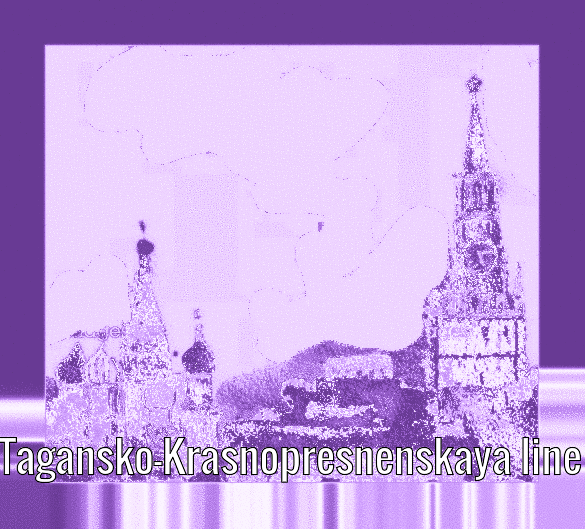
The Tagansko–Krasnopresnenskaya line (Russian: Таганско-Краснопресненская линия, IPA: [tɐˈɡanskə krəsnɐˈprʲesʲnʲɪnskəjə ˈlʲinʲɪjə], formerly Zhdanovsko-Krasnopresnenskaya (Ждановско-Краснопресненская) (Line 7) is the busiest line of the Moscow Metro. Built in 1966–1975 and extended in 2013–15, it cuts Moscow on a northwest-southeast axis and contains 23 stations.
Tagansko–Krasnopresnenskaya line is a classic example of Soviet urban planning, sometimes referred to as the seventh stage of the Metro. Construction began in the early 1960s, and in 1966 the first complete segment was opened. In the practice of Moscow radial line openings, it began at the ring and left through to the new housing massifs on the southeast of Moscow, originally called the Zhdanovskaya line (Ждановская линия). The construction of the new radius was designed to maximize the efficiency of it with the land-based transportation. All the stations were built on major transport links and the stations Tekstilschiki and Vykhino were integrated into a single transport complex with the railroad stations.
The path began at the Taganka Square (on the ring) and followed the Marxist street/Volgograd avenue through the neighbourhoods of Pechatniki, Kuzminki and Tekstilshchiki. On its final stretch, the line deviates from the Volgograd avenue and crosses onto the Ryazan avenue and terminates at a combined cross-platform transfer to the railways at Vykhino.
Although the geology of the line was unfavourable, so to cut down costs, the builders adopted a cut-and-cover method for tunnel construction building them out of large concrete boxes. In some cases, like the second stretch of the Volgogrdsky Prospekt-Tekstilshchiki path, in a rare occurrence for Moscow, the track goes on the surface, as with the approach to Vykhino.
In a similar logic that was shown when building the Kaluzhsko–Rizhskaya line, it was decided to postpone the central section in favour of building the new radial line, however after the opening of the new Zhdanovskaya line in late 1966, the passenger traffic between it and the former Kaluzhskaya line overstretched the capacity of the ring between Oktyabrskaya and Taganskaya. The two presented itself a unique opportunity and in late 1970 Moscow Metro’s first cross-platform transfer point was opened at Kitay-Gorod.
Construction of the Krasnopresnensky radius was in built in much more difficult conditions, in a similar fashion it was designed to make the new massifs of the northwestern Moscow accessible, however the more dense regions, underground fortifications and communication lines that the builders had to face, the first stage of the Krasnopresnensky radius knows no equals in the number of difficulties that the builders were faced with. Beginning at the ring, where the only deep level station was located, the line follows the Krasnaya Presnya street and then turns north along the 1905 year street, further work was hampered by the necessity to cross under the sorting yard of the Belorussky Rail Terminal with a total of 27 individual railroads, and when building the last stretch Polezhayevskaya-Oktyabrskoye Pole. In both cases, the soil was typical sand that was used to elevate the railways, which made it impossible to bore under using conventional means. Firstly chemical adhesive had to be used to strengthen it so that when drained, it would not fall in. To avoid a collapse after the shield bored its way, a horizontal platform had to be installed above it, and the TBM moved at maximum pressure, without any temporary joining in the sand. Just like the Zhdanovskaya line, the line relieved major transport arteries and congestion, Begovaya was built similarly to Tekstilshchiki with exists from subways coming straight onto railway platforms.
As four of the five stations were sub-surface, an attempt was made to modernise the existing centipede design. The volume of the station space was increased, and to support the larger roof, the size of the pillars was raised, but so was their spacing, from 4 to 6.5 metres. In the end, instead of the two rows of 40, there was 2 of 26. The new design became very widespread in the rest of the system. The architecture also made a comeback with new stations. For the first time in nearly 20 years, marble was used on station walls.
Building the final part of the line commenced shortly afterwards on the central stretch finally linking up the Zhdanovskaya line, and finishing the Krasnopresnensky radius. The former was built with two deep level column stations, one of the centrepieces was the increased diameter of the central vault of 9.5 metres, as well as the rich architecture methods used. The latter section encountered a significant difficulty when building under the Moscow Canal. To avoid flooding, boring had to be done in the winter, and a three-metre thick plane of ice had to be placed on the canal bed. Afterwards, the line continued into the northern regions of Shchukino and Tushino, including another combined railway link at Tushinskaya. The station Skhodnenskaya was another pioneering design, which consisted of a single vault technology initially developed for the Kharkiv Metro, it too became common elsewhere in the Soviet Union. Another station on this stretch was left unfinished because of the lack of need for it and remained derelict for thirty years. The station was completed and inaugurated in August 2014 under the name Spartak.
Because the line is the busiest on the system, there are significant problems that overstretch its capabilities. In particular is the station Vykhino, which was built with too small a capacity to handle the congestion, making it the busiest on the system. In 2004 a severe reconstruction increased the area of the platforms and gave the station a desirable facelift. Nonetheless, that was insufficient to solve the problem, and in 2013 the line was extended to the south-eastern districts of Moscow outside the Ring Road with the opening of Zhulebino and Lermontovsky Prospekt stations. By September 2015, the line has reached a neighboring city of Kotelniki with the construction of an eponymous metro station there. The Kotelniki station opened on 21 September 2015 and became the new terminus of the southeastern radius.
-
Taganskaya
-
Proletarskaya
-
Volgogradsky Prospekt
-
Tekstilshchiki
-
Kuzminki
-
Ryazansky Prospekt
-
Vykhino
-
Kitay-gorod
-
Oktyabrskoye Pole
-
Polezhayevskaya
-
Begovaya
-
Ulitsa 1905 Goda
-
Barrikadnaya
-
Pushkinskaya
-
Kuznetsky Most
-
Planernaya
-
Skhodnenskaya
-
Tushinskaya
-
Shchukinskaya
-
Lermontovsky Prospekt
-
Zhulebino
-
Spartak
-
Kotelniki


